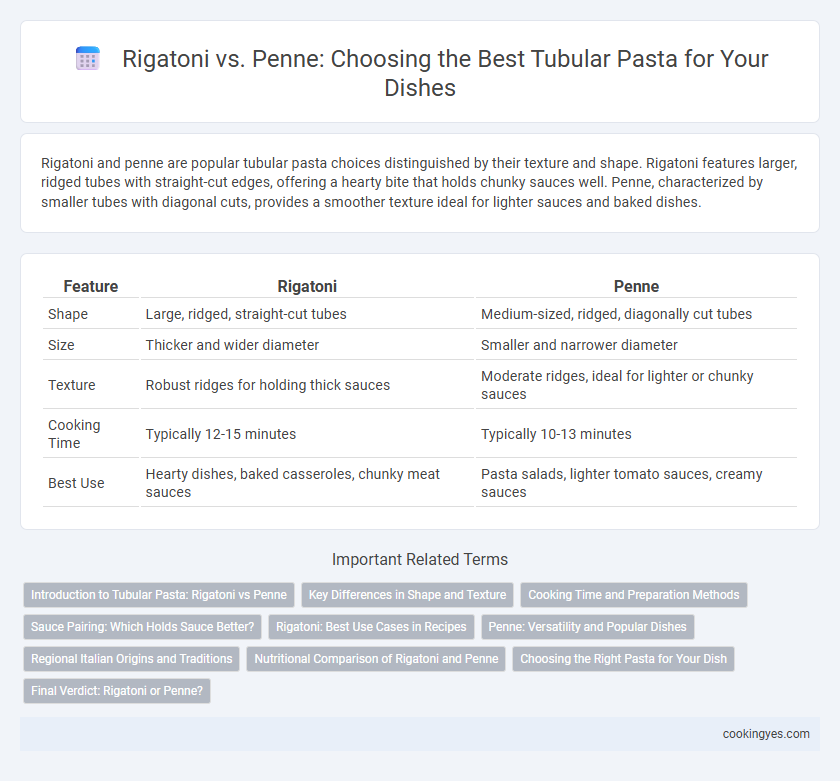Rigatoni and penne are popular tubular pasta choices distinguished by their texture and shape. Rigatoni features larger, ridged tubes with straight-cut edges, offering a hearty bite that holds chunky sauces well. Penne, characterized by smaller tubes with diagonal cuts, provides a smoother texture ideal for lighter sauces and baked dishes.
Table of Comparison
| Feature | Rigatoni | Penne |
|---|---|---|
| Shape | Large, ridged, straight-cut tubes | Medium-sized, ridged, diagonally cut tubes |
| Size | Thicker and wider diameter | Smaller and narrower diameter |
| Texture | Robust ridges for holding thick sauces | Moderate ridges, ideal for lighter or chunky sauces |
| Cooking Time | Typically 12-15 minutes | Typically 10-13 minutes |
| Best Use | Hearty dishes, baked casseroles, chunky meat sauces | Pasta salads, lighter tomato sauces, creamy sauces |
Introduction to Tubular Pasta: Rigatoni vs Penne
Rigatoni and penne are popular tubular pasta varieties distinguished by shape and texture; rigatoni features large, ridged tubes with a slightly curved shape, while penne is smaller, smooth or ridged, and cut diagonally. Rigatoni's ridges and wide diameter make it ideal for thick sauces and chunky ingredients, maximizing flavor retention. Penne's versatile size and shape work well with lighter sauces and baked dishes, providing a balanced pasta choice for various recipes.
Key Differences in Shape and Texture
Rigatoni features large, ridged tubes with straight-cut edges that enhance sauce adherence and provide a chewy texture, while penne is characterized by smaller, smooth or ridged tubes with diagonal-cut edges that allow for a tender bite. The straight edges of rigatoni create a substantial surface area ideal for capturing chunky sauces, whereas penne's angled ends enable better sauce flow inside the pasta. Texture-wise, rigatoni offers a heartier mouthfeel suitable for robust meat or vegetable sauces, contrasting with penne's lighter texture that pairs well with creamy or thin sauces.
Cooking Time and Preparation Methods
Rigatoni typically requires a longer cooking time than penne due to its larger diameter and thicker walls, allowing it to hold sauces more effectively. Penne cooks faster and offers versatility in preparation methods, including baking, boiling, and grilling, making it ideal for quick meals. Both pasta types benefit from al dente cooking to maintain texture and prevent mushiness during sauce absorption.
Sauce Pairing: Which Holds Sauce Better?
Rigatoni's wide ridges and larger diameter capture thick, chunky sauces such as Bolognese or creamy Alfredo more effectively than penne, making it ideal for hearty dishes. Penne's smooth texture and diagonal cut work better with lighter, oily, or herb-based sauces like marinara or pesto, allowing flavors to coat the pasta evenly without overwhelming texture. When selecting tubular pasta based on sauce pairing, rigatoni holds thick sauces better, while penne excels with thinner, more delicate sauces.
Rigatoni: Best Use Cases in Recipes
Rigatoni's wider, ridged tubes make it ideal for hearty sauces like Bolognese or chunky vegetable ragu, as its texture holds sauce better than penne. The larger diameter accommodates thick ingredients such as sausage or roasted vegetables, enhancing the bite. Rigatoni is best used in baked pasta dishes, where its robust structure maintains shape and captures melted cheese effectively.
Penne: Versatility and Popular Dishes
Penne stands out in tubular pasta selections for its versatility and widespread culinary appeal, easily adapting to a variety of sauces from rich tomato-based to creamy Alfredo. Its diagonal cuts and hollow center hold sauces effectively, enhancing flavor in dishes like Penne alla Vodka and baked ziti. Penne's popularity in both traditional Italian cuisine and contemporary recipes makes it a go-to choice for home cooks and professional chefs alike.
Regional Italian Origins and Traditions
Rigatoni, originating from Rome and Southern Italy, features ridged, wider tubes that hold chunky sauces like amatriciana, reflecting the region's rich culinary traditions. Penne, with its origins in Northern Italy, especially Liguria and Campania, is characterized by smaller, diagonally cut tubes ideal for lighter sauces and baked dishes, aligning with northern Italian cooking styles. Both pastas embody distinct regional uses, showcasing Italy's diverse pasta heritage shaped by local ingredients and cooking techniques.
Nutritional Comparison of Rigatoni and Penne
Rigatoni and penne pasta share similar nutritional profiles, both providing approximately 200 calories per 2-ounce dry serving, with around 7 grams of protein and 40 grams of carbohydrates. Rigatoni's larger diameter slightly increases its fiber content compared to penne, contributing to better digestive health and sustained energy release. Both pasta types are low in fat and sodium, making them excellent options for balanced meals when paired with nutrient-rich sauces and vegetables.
Choosing the Right Pasta for Your Dish
Rigatoni features large, ridged tubes perfect for holding thick sauces and chunky ingredients, enhancing flavor absorption in hearty dishes like baked pasta or ragu. Penne, with its smaller, diagonally cut tubes and subtle ridges, excels in lighter sauces and pasta salads, providing a balanced texture without overwhelming delicate flavors. Selecting rigatoni or penne depends on the sauce consistency and dish type, ensuring optimal sauce retention and complementary mouthfeel.
Final Verdict: Rigatoni or Penne?
Rigatoni features larger, ridged tubes ideal for holding chunky sauces, making it perfect for hearty dishes like Bolognese or sausage ragu. Penne's smaller diameter and smooth or ridged surface work well with lighter sauces, pesto, or baked pasta recipes due to its versatility and ease of layering. Choosing rigatoni over penne depends on whether you prefer a robust bite with sauce retention or a more adaptable pasta suited to various culinary styles.
Rigatoni vs penne for tubular pasta selections Infographic

 cookingyes.com
cookingyes.com